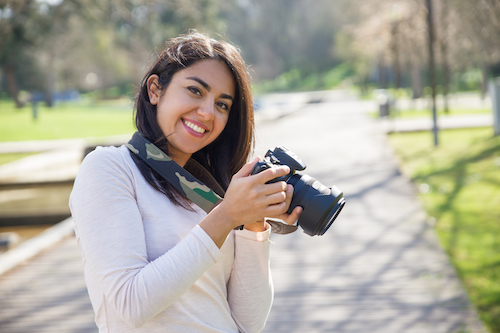Contents
When it comes to online shopping, looks matter. Customers can’t browse products up close like they can in a store, meaning that you need to take quality photos for your Etsy shop.
Here’s how to take product photos for your Etsy shop.
1. Invest in quality lighting
When you can get it, natural lighting is beautiful and one of the best forms of lighting for professional product photography. A good studio light will deliver more consistent results.
When it comes to photographing products, then you can’t go wrong with softboxes and ring lights. Both types of lighting deliver an even spread of lighting throughout your frame, with minimal shadows. When choosing between the two, softboxes are great for shots at a short distance, for example, lifestyle shots, while ring lights are preferred by macro photographers, making them perfect for close-up, detailed shots of your product.
2. Think about your background
If you are taking photos for your Etsy shop at home, the last thing you want is your household clutter creeping into the background. If you are going for a low-key lifestyle setup for your product photos, make sure that your space is clean and tidy before you start shooting.
Alternatively, a designated backdrop will put your mind at rest, while also adding a touch of class to your shop. When choosing a backdrop for product photography for your online store, a plain white background is a safe and proven option. You can purchase a dedicated photographic backdrop or go with DIY photo backdrop options to save money.
3. Spend some time on your composition
Composition refers to where subjects are placed within your image. While you don’t need to go to the extremes of the Dutch masters when composing your work, a little bit of time and care can make your product photos more appealing to shoppers.
Brush up on the basics of art, such as the rule of thirds. Some other Etsy photography tips include making sure your images don’t have too much space around the edges, which will let your product stand out. Take plenty of photos, attempting to photograph your product from every possible angle. Shoppers will feel more confident in you as a seller, and you will appear more trustworthy with this approach.
4. Learn some manual settings
Having a basic understanding of how a camera works and what key camera settings do can ensure that you capture sharp and detailed pictures in any condition. This is important when learning how to take product photos at home.
The three key settings to pay attention to are ISO, shutter speed and aperture, which are collectively known as the exposure triangle. Your ISO should be set as low as possible to minimise image noise, while your shutter speed should be set to about 125th of a second if you are shooting handheld to avoid blur.
Aperture can be used to control the depth of field in your image, with a larger aperture or smaller number helping you to achieve more background blur. If you can get all of these settings correct in unison, you’ll be onto a winner. If you are having trouble with this, consider using the aperture or shutter priority settings on your camera.
5. Do some basic edits
While you don’t need to become a Photoshop expert, some basic edits go a long way to capturing great product photographs. You can learn how to edit product photos easily using apps on your phone.
If you shoot in RAW, you can edit the white balance, exposure and contrast of your images with ease and without diminishing the quality of your image. In the editing stage, you can also spend some time cropping and resizing your images, aiming for a consistent border and size, as well as making sure your photos are straight. These small adjustments go a long way towards producing more professional product photography.
6. Use the right gear
We’ve touched on lighting before, but there are a few other essential items that you should have in your product photography kit.
- Tripod – A tripod or phone stand, is a great way to make sure that your camera is perfectly still as you shoot. This reduces the appearance of camera shake. With your camera mounted on a tripod, you can also make more considered adjustments to your image composition.
- The right camera lens – This can vary depending on the type of product you are photographing. In most cases, the best lens for product photography is a standard zoom lens. A macro lens is a must-have for close-up shots of small products, such as jewellery.
- The best camera for product photography – To capture the highest quality, most detailed images, we recommend everyone consider purchasing a DSLR or mirrorless camera. These cameras are also perfect for honing your manual photography techniques and are compatible with a wide range of accessories and lenses. If you don’t want a DSLR camera, you can still improve your smartphone photography results with the help of a few accessories, such as clip-on phone lenses and portable LED lighting kits.
“The opinions expressed by BizWitty Contributors are their own, not those of BizCover and should not be relied upon in place of appropriate professional advice. Please read our full disclaimer."







